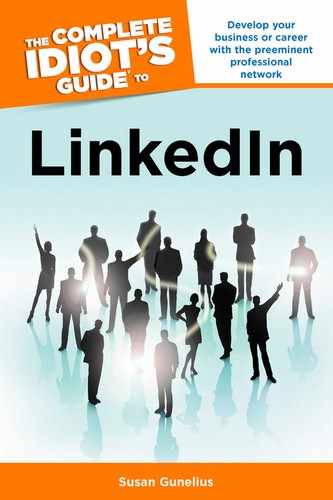Define Your Target Audience
As you learned in the previous section of this chapter, developing your LinkedIn strategy requires that you define your target audience. In marketing terminology, your target audience is the segment of the larger population that you focus your efforts on in order to best meet your overall business and brand objectives. You have to analyze and define several specific demographic and behavioral attributes to define your target audience.
For example, you can segment a broader audience using demographic characteristics such as these:
• Age
• Gender
• Education
• Location (where they live and work)
• Work (employer, industry, profession, and so on)
You can also segment a broader audience using behavioral characteristics. Social networking and online behaviors are particularly helpful in segmenting your target audience for your LinkedIn initiatives. Examples of behavioral attributes can include …
• Social sites where they have active profiles.
• Groups, blogs, and forums where they actively publish content and conversations.
• The type of content they like based on social sharing tools such as Facebook’s Like button, Google+’s +1 button, Digg.com, StumbleUpon.com, Twitter’s Retweet button, and so on.
• The people they follow and interact with on social sites.
• The types of products, businesses, and brands they publish reviews about online.
Use these traits to develop a profile of your best customer or the ideal person you want to connect with on LinkedIn to reach your goals. As you spend more time analyzing the broader audience and determining what type of people you want to connect with based on demographic and behavioral characteristics, you’ll begin to learn where similar people spend time online, what they talk about, what’s important to them, and how they like to be contacted on and off LinkedIn. Use these findings to develop your LinkedIn strategy, so your efforts are spent interacting and building relationships with the right people.
| QUICK TIP |
Simply connecting with people on LinkedIn, as you’ll learn to do in Chapter 5, isn’t enough. If you want to reach your goals, you need to know who to connect with and what to say to them in order to get them emotionally involved with you, your business, and your brand. That’s the critical step to building relationships with people, and that’s where LinkedIn can help you meet your goals.
Emotional involvement with you, your business, and your brand leads directly to loyalty and brand advocacy (people talking about you, sharing your content, and joining your conversations). This is a concept that I like to explain as the 3 Ss of customer loyalty.
• Stability People feel emotionally involved with you, your business, and your brand when you send them a consistent message in every interaction.
• Sustainability People feel emotionally involved with you, your business, and your brand when they believe that you’ll be with them for a long period of time.
• Security People feel emotionally involved with you, your business, and your brand when you give them a feeling of peace of mind.
In other words, people will feel loyal to you and your relationships will be stronger when they understand what to expect from you, and can trust you to deliver on those expectations every time they interact with you. This is a fundamental principle of brand building that applies to your efforts to build your business or personal brand through LinkedIn, too. Bottom line: Your LinkedIn activities and persona have to be reliable and trustworthy. If they are not, it will be nearly impossible to gain the emotional involvement you need to build relationships that lead to brand advocacy and word-of-mouth marketing.
If no one talks to you, with you, or about you on LinkedIn, then you’re just talking to yourself and you’ll never reach your goals. Define your target audience and deliver the content, conversations, and experiences that they want and need from someone like you. Carve out your niche and your position on LinkedIn as the go-to person for your area of expertise, and then live that brand promise in all of your LinkedIn activities. Not only will the LinkedIn audience take notice, but online influencers will, too, as you’ll learn in the next section.
